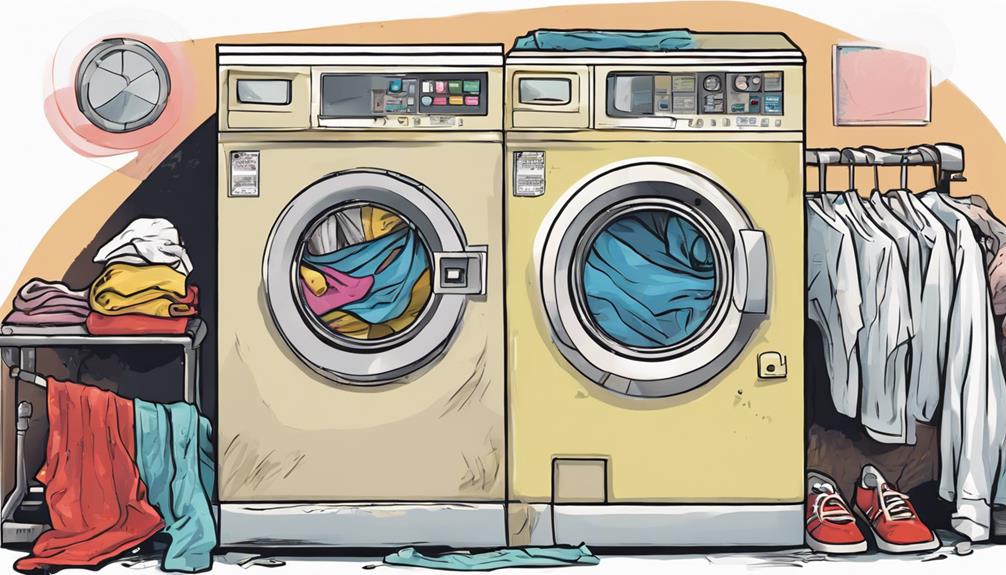The perm press setting on your washing machine is perfect for reducing stubborn wrinkles on fabrics like cotton, rayon, and synthetics. With lower water and heat temperatures, it works to prevent new wrinkles during the slower spin cycles. By using a tailored approach, it maintains the appearance of your clothes while being gentle on the fabric fibers. Remember, it's important to check care labels for suitability and promptly remove clothes to prevent wrinkles. Using the perm press setting efficiently can save you time on ironing and keep your garments looking smooth and neat.
Key Takeaways
- Perm Press reduces wrinkles in clothes effectively.
- Designed for fabrics like cotton, rayon, and synthetics.
- Operates at lower water and heat temperatures.
- Slower spin speeds maintain clothing appearance.
- Ideal for preventing wrinkles and maintaining fabric finish.
Understanding Perm Press Setting
To grasp the purpose and benefits of the perm press setting, consider it as your secret weapon against stubborn wrinkles in laundry care.
Permanent press cycles are specifically designed to reduce wrinkles by operating at lower water and heat temperatures, along with slower spin speeds. This tailored approach prevents new wrinkles from setting in while maintaining the appearance of your clothing.
Fabrics such as cotton, rayon, and synthetic materials, which are prone to wrinkling, benefit greatly from using the Permanent Press option on your washing machine.
How Perm Press Cycle Works

The Perm Press cycle effectively minimizes wrinkles by utilizing cooler water temperatures and slower spin speeds in your washing machine. This setting is designed to cater to fabrics that are prone to wrinkling, such as cotton, rayon, and linen. By using warm water instead of hot water, the Perm Press cycle guarantees that the fabric fibers relax without getting overly agitated. Additionally, the slower spin cycles at the end of the washing process help maintain the clothing's appearance by reducing the formation of wrinkles. Below is a table summarizing how the Perm Press cycle works:
| Perm Press Cycle Steps | Description |
|---|---|
| Warm water wash | Relax fabric fibers |
| Shorter agitation | Prevent excessive wrinkling |
| Cold water rinse | Remove detergent residue |
| Slower final spin | Minimize wrinkles during drying |
Perm Press Vs. Normal Cycles

Perm Press cycles differ from normal cycles in their approach to laundry care, focusing specifically on reducing wrinkles rather than solely emphasizing cleaning efficiency and drying speed.
When you opt for the Permanent Press Setting, you're choosing a vital treatment for your clothes. Unlike the Normal cycle, which operates at higher temperatures for efficient cleaning and drying, the Perm Press cycle uses lower water and heat temperatures. This difference helps prevent excessive wrinkling in your garments.
Additionally, Perm Press cycles have slower spin speeds, which play an essential role in ensuring that new wrinkles don't set in during the laundry process. By prioritizing wrinkle reduction, clothes washed in the Perm Press cycle are less likely to come out heavily wrinkled compared to those washed using the Normal cycle.
This setting is particularly beneficial for fabrics like cotton and rayon, helping maintain their finish and appearance over time.
Benefits of Using Perm Press

Experience the advantages of selecting the Perm Press setting for your laundry needs. By choosing the Perm Press cycle, you can benefit from reduced wrinkles in your clothes. This setting operates at lower water and heat temperatures, which is gentle on fabrics like cotton, rayon, and linen, helping to prevent new wrinkles from forming.
The Perm Press cycle is specifically designed to simplify garment care and minimize wrinkles, making it ideal for fabrics that are prone to wrinkling. Additionally, synthetic materials such as polyester and nylon also reap the benefits of the Perm Press cycle due to its lower water temperature and spin speed.
The cool-down phase in this cycle plays an important role in reducing creases in fabrics, ultimately preserving the quality and appearance of your clothing. So, next time you do laundry, consider using the Perm Press setting to keep your clothes looking fresh and wrinkle-free longer.
When to Use Perm Press

Selecting the Perm Press setting is recommended when dealing with fabrics that are prone to wrinkling. The Permanent Press cycle uses a combination of warm wash and cool rinse to prevent wrinkles in garments like cotton, rayon, linen, polyester, and nylon. It's ideal for clothing with permanent press finishes.
However, avoid using the Perm Press cycle for delicate items such as lingerie and undergarments as they may get damaged. Check the care labels on your clothes to determine if they're suitable for the Perm Press setting.
Using the Perm Press cycle helps maintain the appearance of your garments and reduces the formation of new wrinkles. Remember that clothes washed in the Perm Press cycle should be promptly removed from the machine to prevent wrinkles from setting in.
Tips for Effective Perm Press Use

To effectively use the Perm Press setting, remember to:
- Sort clothes by fabric type and color to maintain quality and reduce wrinkles.
- Avoid overloading the washer or dryer to guarantee proper garment care.
- After the cycle ends, promptly remove clothes to prevent new wrinkles.
- Hang up wrinkle-resistant fabrics slightly damp to further minimize wrinkles.
These tips will help ensure your clothes are well taken care of and remain wrinkle-free.
Perm Press Benefits
For effective use of the Perm Press setting, sort your clothes by fabric type and color to maintain their appearance and reduce wrinkles.
The benefits of utilizing the Permanent Press setting include:
- Reduced Wrinkles: The Perm Press setting helps to minimize wrinkles on fabrics that are prone to creasing, such as cotton, rayon, and linen.
- Fabric Care: Operating at lower water and heat temperatures with slower spin speeds, the Perm Press setting guarantees gentle care for your clothes, helping to preserve their quality over time.
- Prevention of New Wrinkles: By using the Perm Press setting, you can thwart new wrinkles from setting in your clothes, keeping them looking fresh and neat.
- Maintained Fabric Finish: This setting aids in preserving the finish of your garments, ensuring that they retain their original look and feel even after multiple washes.
Proper Load Mixing
Properly mixing your laundry loads based on fabric type and color is key to maximizing the benefits of the Perm Press setting in your washing machine. When using Perm Press, it's crucial to mix loads wisely. Sort your clothes by fabric type before starting the cycle.
Combining similar fabrics helps prevent heavy wrinkles and keeps your garments looking their best. Avoid mixing delicate items with sturdier fabrics in the same load to guarantee proper care. Sorting clothes by weight and thickness can also lead to better results.
Ironing Recommendations
Use a moderate temperature setting on your iron to press perm press clothes effectively.
When ironing, remember to turn the clothes inside out to prevent shine or damage to the fabric's finish.
It's best to avoid using steam when pressing perm press garments to maintain their appearance.
Before ironing the entire garment, test a small inconspicuous area first to confirm the iron temperature is suitable for the fabric.
To guarantee a crisp look, start by ironing collars, cuffs, and hems first. This helps maintain the shape of the garment and gives it a polished finish without damaging the fabric.
By following these ironing recommendations, you can keep your perm press clothes looking fresh and wrinkle-free for longer periods.
Perm Press in the Dryer

To dry your clothes using the Permanent Press cycle in the dryer, select the appropriate setting that utilizes medium heat to prevent overheating.
This cycle is designed to reduce wrinkles by incorporating a cool-down period at the end of the drying process. The medium heat helps maintain the fabric's finish and reduces creases, making it ideal for wrinkle-prone garments.
For even better results, consider hanging up wrinkle-resistant fabrics while they're still slightly damp from the Permanent Press dryer cycle. This extra step can further minimize wrinkles and guarantee your clothes look neat and well-maintained.
Always remember to check the care labels on your garments for specific instructions on using the Permanent Press cycle in the dryer. By following these guidelines, you can effectively dry your clothes while keeping them looking fresh and wrinkle-free.
Frequently Asked Questions
What Does Perm Press Setting on Washer Do?
The Perm Press setting on your washer reduces wrinkles by using lower water temps and gentler spins. It's perfect for fabrics like cotton and linen. Keep your clothes looking sharp with this setting!
What Is the Difference Between Perm Press and Delicate?
Do you know the difference between perm press and delicate cycles? Perm press is for everyday clothes, reducing wrinkles with warm water and slow spins. Delicate is gentler, best for lace and silk. Choose wisely!
What if I Don't Have a Permanent Press Cycle?
If you don't have a permanent press cycle, try using a gentle or delicate setting with cool or warm water and a slower spin speed. Remember to promptly remove clothes to prevent wrinkles and hang wrinkle-resistant fabrics damp.
Is Permanent Press the Hottest Dryer Setting?
If you're wondering, permanent press isn't the hottest dryer setting. It actually uses medium heat to reduce wrinkles gently. So, you can breathe easy knowing your clothes are getting a wrinkle-free treatment without scorching heat.
Conclusion
To sum up, the perm press setting is a valuable tool in your laundry arsenal, offering a convenient way to keep your clothes looking fresh and wrinkle-free.
Understanding how this cycle works, its benefits, and when to use it can make a significant difference in the lifespan of your garments.
By following these tips and using perm press effectively, you can guarantee that your clothes come out of the wash looking their best every time.










